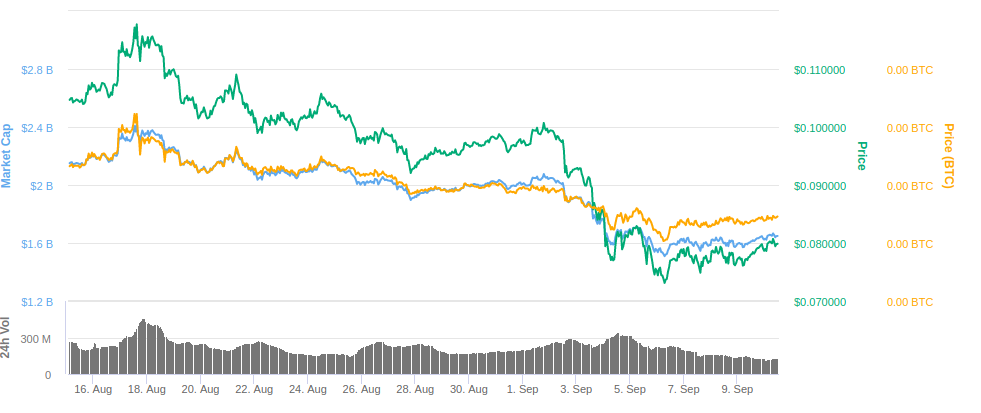
Stellar XLM was one of the best-performing ‘traditional’ cryptos in 2020, earning investors over 75%. The price is currently down, making XLM a good buying opportunity. How strong are Stellar’s fundamentals and what makes it different from other top-20 cryptos?
10 key facts about Stellar XLM
1) Launched in 2014;
2) 14-th largest crypto by market capitalization ($1.63bn, CoinMarketCap, September 2020)
3) Appreciated by 79% between January and September 2020;
4) Founded by Jed McCaleb, the famous crypto entrepreneur who also created Ripple and Mt Gox exchange;
5) Managed by the non-profit Stellar Development Foundation;
6) Consensus algorithm: Stellar Consensus Protocol (SCP);
7) Total supply: circa 50 billion XLM;
8) Stellar is the name of the blockchain, while the coins themselves are called lumens;
9) Stellar blockchain transaction fee is just 0.00001 lumens;
10) Transactions take a few seconds to confirm.
Why was Stellar XLM created?
The main objective of Stellar XLM is to provide financial solutions for the unbanked and cheap cross-border payments. If things go as planned, in the future the Stellar blockchain will underlie a massive network of international money transfers and remittances, all for a fraction of the cost of traditional bank payment, Western Union and the like.
In fact, Stellar fees are so low that you’d have to make hundreds of thousands of transactions to spend even $1. In case you’re asking why have transaction fees at all, the answer is that the fees protect the network from spammers.
The true power of Stellar XLM is the possibility to tokenize any asset, including fiat money. You can create a digital version of USD, euro, etc. on the Stellar blockchain and send them to anybody else in the world in seconds and virtually for free. But for this to work, you need a network of so-called anchors – banks and savings institutions that will swap fiat funds for digital assets.
Near-free money transfers for all – Stellar wallet
Imagine that you work in another country and want to send money home. You come to an anchor and hand in some money in the local currency – say, US dollars. In exchange, the anchor (bank) issues you with an equivalent amount of ‘Stellar dollars’, or tokens, which are instantly deposited in your Stellar wallet. You send them to the Stellar wallet of a family member back home – your wife, for instance. She goes to her nearest anchor institution and redeems the digital tokens for her local currency.
How close is Stellar to making this bold vision a reality? To be fair, there’s still quite a long way to go, but the Stellar Foundation constantly expands its range of partnerships in the financial industry. For example, in May 2020 it partnered up with Abra – a wallet and investment platform that allows users to buy 100 different crypto coins and 65 fiat currencies. Another interesting project is Lightnet – a Bangkok-based company that expects to move $50 billion worth of remittances on the Stellar blockchain by 2022.
How to use Stellar
To hold and send XLM, you’ll need either a dedicated Stellar wallet or a multi currency wallet with Stellar support. Wallets built for Stellar include Lobstr, StellarX, Stellarport and Lumenshine. If you prefer a multicurrency crypto wallet, you can use Coinbase, Atomic Wallet, Guarda, Blockchain.com, etc.
Note that wallets created specifically for XLM can also hold any assets built on the Stellar blockchain.
If you don’t have any lumens yet, you can buy them on most major exchanges, such as Binance, Poloniex, Kraken, and so forth. Stellar also has its own decentralized exchange, called StellarX, where you can trade for free: there are no fees whatsoever.
What’s next for Stellar XLM price?
XLM has had a very successful year so far, increasing in price by over 75% since January 1. But the second half of August and early September were marked by a price slump: XLM/USD went down 27% between Aug 15 and Sep 10.

There’s no reason to talk about a real downtrend, however. The coin’s fundamentals are still strong, considering the steady flow of new partnerships in the recent months. Plus, Stellar XLM correlates with Bitcoin to a certain point, and BTC is expected to resume growth. This means that September 2020 is a good moment to buy lumens on a dip.
While it’s unlikely that the price of Stellar XLM will double until the end of the year, a 15-25% increase in price is completely possible. Stellar XLM is a worthy addition to a balanced investment portfolio, even if it doesn’t attract as much media attention as Chainlink, Polkadot, and other trendy infrastructure projects.
Stellar XLM isn’t a hype coin like some of the staking or DeFi assets that can rise 50% in a few days and then collapse; instead, it’s a reliable coin that provides real value to the ecosystem. If you are willing to wait for a while to reap your gains, then XLM is the right asset for you.
